|

by TGM
December 2004
from
TheMilleniumGroup Website
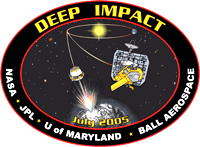 Much of science today is built upon
ideas that are outdated and poor first guesses. But the actual
definition of science is that it nourishes itself on its past
accomplishments. It is my hope that over the next few months that
science, specifically space science, will be faithful to its real
nature. Much of science today is built upon
ideas that are outdated and poor first guesses. But the actual
definition of science is that it nourishes itself on its past
accomplishments. It is my hope that over the next few months that
science, specifically space science, will be faithful to its real
nature.
Sometime in January JPL will be watching as they blast off the Deep
Impact Satellite from Cape Canaveral. The satellite has two
components; the impactor and the satellite. The impactor is a 1 x 1
meter, 820 pound, copper headed little beasty.
It is designed to
create a crater between the size of a house, up to the size of a
football field. They are going to set the impactor in the path of
Temple 1. The comet will hit the impactor at a speed of 23,000 miles
an hour.
So what is the big deal about this project. Let's take a closer look
at some of the issues.
I will be using the
press release numbered 04-392.
There are a number of images, animations, comet images and other
tidbits at the
Deep Impact Website. The website is
actually very well done and has some good info and images. I would
encourage you to take a good look at it, including the
Small
Telescope Science Program.
You might note some familiar names there.
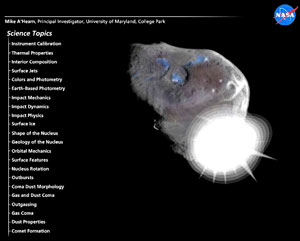
click above image to
watch animation
(large file - allow 1
minute about to fully load)
The first issue that I would like to
approach is the assumed idea that the solar system came about via
The Accretion Theory.
The Accretion Theory, strictly speaking states
that the sun passed through a gaseous cloud and the planets were
formed out of the material from the cloud. However, most space
scientists today believe that the solar system began forming around
12 billion years ago. The sun was spinning and formed a disk out of
which the planets formed.
Most of the writers and scientists for TMG, of course do not
subscribe to this theory. The larger majority of TMG members
subscribe to the ideas and theories of
Velikovsky and also to
Creationism, or somewhere in that general vicinity.
James McCanney's
theories are also high on our list. So of course this experiment is
troubling.
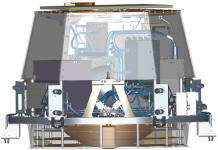 The following quote is from the
Deep Impact Web page: The following quote is from the
Deep Impact Web page:
"The Deep Impact mission will dig deep beneath the surface of a
comet to get a first-ever look at the frozen collection of ice and
dust left over from the formation of the solar system. Why are we
doing it? We learn about comets by studying the ice and dust that
flows naturally from a comet as it is warmed by the Sun."
Not only does this quote state that they expect to find answers to
support their theory of solar system formation, but it also states
that they believe that comets are ice and dust. With this theory
there isn't really a satisfactory explanation of why some of the
moons travel in the opposite direction of the planets in the plane,
nor why some of the planets spin against or spin at different speeds
or not at all.
One thing that has always perplexed us, is
the claim that the sun heats the nucleus of the comet and that this
causes the outflow of gasses. To do this the claim is that the
comets begin to outgas H2O somewhere roughly between 2 and 3AU's (AU
= 93,000,000 Miles). Other gasses sublimate (the term for solids
turning directly into a gas) at farther distances.
The coma is made
up of these sublimated gasses as is the tail of the comet.
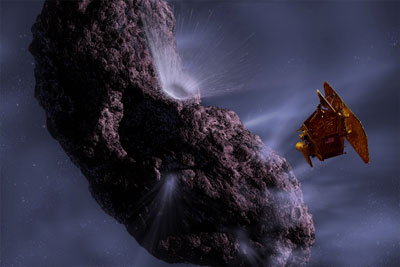
(Artwork, Pat Rawlings)
The comet
Hale Bopp, for instance, measured 12,000 miles out past Jupiter. The
question is, was it already sublimating or was it the actual size of
the comet? This question and the others that we posed, sure stirred
up a swarm of angry scientists at us. But the questions were never
satisfactorily answered. Another point should be made here
concerning
comets. There has been at least two famous recent comets that no
water, (CO2, CO, CS, or OH) were found:
Shoemaker-Levy and Borelly.
We suspect that there are many others. Check out our past page on
Hale Bopp concerning these issues click
HERE.
Preparing for Deep Impact:
"We will be capturing the whole thing on the most powerful camera to
fly in deep space," said University of Maryland astronomy professor
Dr. Michael A'Hearn, Deep Impact's principal investigator. "We know
so little about the structure of cometary nuclei that we need
exceptional equipment to ensure that we capture the event, whatever
the details of the impact turn out to be," he explained.
Also you might want to read our report
on the Comet Borrelly (below):
|
Deep Space 1 finds Comet
Borrelly
has hot, dry surface
NASA/JPL NEWS RELEASE
Posted: April 7, 2002
Comets are sometimes described as “dirty snowballs,” but
a close flyby of one by NASA’s Deep Space 1 spacecraft
last fall detected no frozen water on its surface.
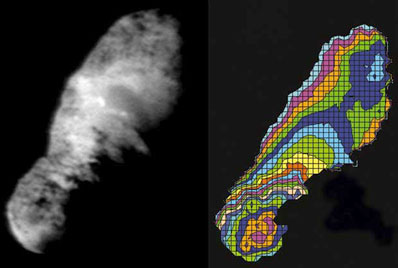
Comet Borrelly and its topographical map
Photo: NASA/JPL
.
Comet Borrelly has plenty of ice beneath its tar-black
surface, but any exposed to sunlight has vaporized away,
say scientists analyzing data from Deep Space 1, managed
by NASA’s Jet Propulsion Laboratory, Pasadena, Calif.
“The spectrum suggests
that the surface is hot and dry. It is surprising
that we saw no traces of water ice,” said Dr.
Laurence Soderblom of the U.S. Geological Survey’s
Flagstaff, Ariz., station, lead author of a report
on the Borrelly flyby results appearing in the
online edition of the journal Science.
.
“We know the ice is
there,” he said. “It’s just well-hidden. Either the
surface has been dried out by solar heating and
maturation or perhaps the very dark soot-like
material that covers Borrelly’s surface masks any
trace of surface ice.”
The Deep Space 1 science
team released pictures and other initial findings days
after the spacecraft flew within 2,171 kilometers (1,349
miles) of the comet’s solid nucleus on September 22,
2001. This week’s report provides additional details
about the nucleus and the surrounding coma of gases and
dust coming off of the comet as measured by one of Deep
Space 1’s scientific instruments.
“Comet Borrelly is in
the inner solar system right now, and it’s hot,
between 26 and 71 degrees Celsius (80 and 161
degrees Fahrenheit), so any water ice on the surface
would change quickly to a gas, “ said Dr. Bonnie
Buratti, JPL planetary scientist and co-author of
the paper. “As the components evaporate, they leave
behind a crust, like the crust left behind by dirty
snow.”
Borrelly is unusually dark
for an object in the inner solar system. The comet’s
surface is about as dark as a blot of photocopy toner,
possibly the darkest surface in the solar system. It is
more like objects in the outer solar system such as the
dark side of Saturn’s moon Iapetus and the rings of
Uranus.
“It seems to be
covered in this dark material, which has been
loosely connected with biological material.” Buratti
said. “This suggests that comets might be a
transport mechanism for bringing the building blocks
of life to Earth.”
Comets may have played an
important role in supplying organic materials that are
required for life to originate. Soderblom points out
that Borrelly’s old, mottled terrain with dark and very
dark spots— different shades of black—are apparently
inactive. Ground-based observations estimated that 90
percent of Borrelly’s surface might be inactive, and the
observations taken by Deep Space 1 show that this is
indeed true.
“It’s remarkable how
much information Deep Space 1 was able to gather at
the comet, particularly given that this was a bonus
assignment for the probe,” said Dr. Marc Rayman,
project manager of the mission. Deep Space 1
completed its original goal to test 12 new space
technologies and then earned extra credit by
achieving additional goals, such as the risky
Borrelly flyby. “It’s quite exciting now as
scientists working with this rich scientific harvest
turn data into knowledge.”
Deep Space 1 was launched
in October 1998 as part of NASA’s New Millennium
Program, which is managed by JPL for NASA’s Office of
Space Science, Washington, D.C. The California Institute
of Technology, Pasadena, manages JPL for NASA. |
Does this sound like a promise to you?
I wanted to include this
quote, because in the past we have heard scientists associated with
NASA/JPL and the like say that they had cameras, powerful cameras,
and yet the photos were never seen. For example, I was just speaking
of Hale Bopp, remember how they called it the "Comet of the
century"?
Hubble was focused on it and we were told that the images
were restricted for one year following the actual imaging, so that
the scientists could make a living from the publishing. The last
time I looked at the calendar it was almost 2005 and we still only
have a couple of high resolution images from HST! Even after we have
asked and asked and asked for them. The shuttle carried an infrared
telescope on several missions, and after asking a number of times
for those images, we were refused. If any one wants to come forward
with any of these images, we will keep your name in confidence.
So
we're posting this comment to see what we get to see after the
event. In addition to the satellite with these powerful cameras, the
Hubble, the Chandra and Spitzer will be watching. Also
The Small
Telescope Project will be watching (check out the names here, you'll
see a couple of old friends - well maybe they're not friends!).
The following comment took me by surprise!
"In the world of science, this is the astronomical equivalent of a
767 airliner running into a mosquito," said Don Yeomans, a Deep
Impact mission scientist at JPL.
"It simply will not appreciably
modify the comet's orbital path. Comet Tempel 1 poses no threat to
the Earth now or in the foreseeable future," he added.
If you remember, it was Mr. Yeomans that got upset when
Brian Marsden of Harvard stated that a certain asteroid was going to come
very close to the earth in the future. From their conflict (and I
can only imagine what their private conversation was like) the
NASA/JPL machine developed a policy wherein only a certain group of
insiders would be able to discuss such an event prior to the public
knowing.
It's interesting that this quote is even included. Why even
bring it up?
I don't believe that there's a chance that a problem
could develop (and we're one of the most criticized groups around).
We've even had several JPL scientists openly call us quacks or the
like! It's just interesting that they felt the need to add this
quote. What do you make of it?
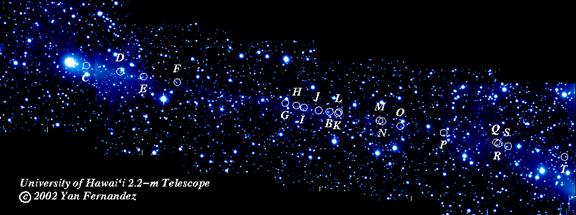
One group believes that the comet will shatter into thousands of
pieces like the comet Toit-Neujmin-Delporte as seen above. They claim
that the explosion will be 16,000 megatons of power (derived from
the 140 million metric tons of mass of the comet) and the pieces
have a a good chance of hitting Mars in the year 2022.
Another interesting point, is that the lead point of the impactor is
made of copper. Isn't copper a very conductive metal? Isn't it a
reasonably soft metal? Just to remind everyone, our belief is that
comets are highly conductive and that what we see as the tail and
the anti-tail are actually the comet's connection to the solar flux
field. The sublimation is actually charges entering and leaving the
comet. You can see a more detailed explanation in
McCanney's
article on small comets.
One of the weirdest items in this whole deal is the fact that the
impact will take place on July 4th. I'm starting to believe the late
Chuck Shramek's idea, that the government plans these dates to
coincide with important Masonic dates.
What do you think?
|

 Much of science today is built upon
ideas that are outdated and poor first guesses. But the actual
definition of science is that it nourishes itself on its past
accomplishments. It is my hope that over the next few months that
science, specifically space science, will be faithful to its real
nature.
Much of science today is built upon
ideas that are outdated and poor first guesses. But the actual
definition of science is that it nourishes itself on its past
accomplishments. It is my hope that over the next few months that
science, specifically space science, will be faithful to its real
nature. 



